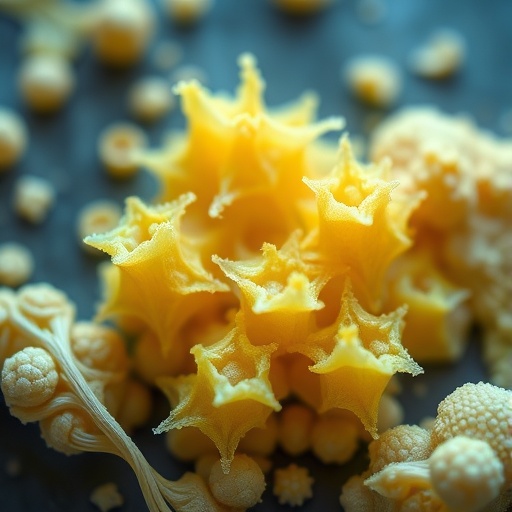The rapid proliferation of electronic devices has brought unparalleled convenience to modern life, but it has also unearthed a formidable challenge: the depletion of rare earth metals necessary for their manufacture. These scarce elements, vital components in everything from smartphones to superconductors, face critical supply shortages exacerbated by the lack of efficient and environmentally sustainable recycling methodologies. As the demand for these metals surges, researchers across the globe are racing to develop innovative solutions that can recover these precious resources from electronic waste without imposing further ecological burdens.
In a remarkable breakthrough, a team of scientists at Osaka Metropolitan University has unlocked the potential of a surprisingly common substance—baker’s yeast—transformed through chemical modification into a powerful tool for metal recovery. This modified yeast, known as sulfated yeast or S-yeast, exhibits exceptional adsorption capabilities, selectively binding heavy and rare earth metal ions from aqueous solutions. This approach represents a paradigm shift in recycling technology, combining eco-friendliness with cost-effectiveness, thereby addressing multiple challenges simultaneously.
The utility of rare earth elements extends beyond consumer electronics, underpinning advanced optical fibers, superconducting materials, and critical clean energy technologies. However, conventional extraction methods are often costly, energy-intensive, and environmentally detrimental. Meanwhile, existing metal recovery techniques, such as chemical precipitation and ion exchange, tend to lack selectivity and scalability. Recognizing these limitations, the researchers sought a biomaterial-based alternative capable of high metal affinity and sustainable regeneration.
Their previous endeavors introduced phosphate-modified baker’s yeast (P-yeast), which demonstrated some success in adsorbing copper ions from polluted solutions. Building on this groundwork, the team engineered sulfated yeast by chemically grafting sulfate groups onto the yeast surface, thereby enhancing its metal-binding affinities significantly. Laboratory experiments revealed that S-yeast exhibits approximately 2.3 times greater copper adsorption capacity compared to its phosphate-modified predecessor, showcasing a profound improvement in efficiency.
Moreover, S-yeast’s desorption profile enables the release of bound metals when treated with hydrochloric acid, allowing the yeast to be regenerated and reused in multiple adsorption-desorption cycles. This recyclability is crucial for practical applications, where continuous operation and minimal waste are paramount. The ability to recover metals repeatedly without sacrificing efficacy positions S-yeast as a potentially revolutionary catalyst for circular economy initiatives within the electronics sector.
Beyond copper, the scientists tested S-yeast’s affinity for other heavy metals, including zinc, cadmium, and lead, as well as rare earth elements integral to high-tech devices. The results were equally promising, with S-yeast outperforming phosphate-modified yeast in adsorbing these diverse metal ions. Such broad-spectrum adsorption could enable comprehensive recovery from complex waste streams, making S-yeast an adaptable tool for addressing multifaceted contamination challenges.
This innovation carries profound implications for mitigating the environmental impact of e-waste. By harnessing a modified microorganism that is both widely available and inherently biodegradable, this method circumvents the drawbacks posed by synthetic adsorbents or harsh chemical treatments. Its scalability and facile regeneration suggest a viable path for industrial-scale metal recycling operations, potentially reducing reliance on hazardous mining processes and enabling resource conservation.
Professor Masayuki Azuma, leading the research group, emphasizes the transformative potential of this approach in creating a sustainable rare earth recovery paradigm. “Our study demonstrates that a simple chemical modification of baker’s yeast drastically enhances its metal adsorption properties,” Azuma remarks. “We are optimistic about advancing this technology towards real-world application, including scaling up production and testing with actual industrial waste fluids.”
The research team’s ongoing efforts include optimizing the synthesis of sulfated yeast to maximize yield and adsorption efficiency, alongside pilot experiments designed to validate performance in complex environmental matrices. Establishing robust protocols for incorporating S-yeast into existing metal recovery infrastructures remains a critical next step to translate laboratory success into commercial viability.
This pioneering study, published in the journal Environmental Research, presents a compelling case for biotechnology’s role in addressing global resource challenges. As electronic waste quantities escalate alongside growing environmental consciousness, sustainable technologies like S-yeast could become cornerstones in circular materials management, fostering innovation that reconciles economic growth with ecological stewardship.
The remarkable synergy of biology and materials science illustrated by Osaka Metropolitan University’s work offers a promising blueprint for future recycling technologies. By repurposing a humble microorganism adapted through precise chemical modifications, researchers have opened new frontiers in selective metal recovery that could reshape the lifecycle of critical materials and enhance global supply chain resilience.
As industry and academia continue to collaborate in exploring green technologies, the potential to unlock hidden value in discarded materials emerges as both a scientific and social imperative. Sulfated yeast provides more than a novel scientific insight; it offers a tangible route to transforming waste into wealth while protecting the planet for generations to come.
Subject of Research: Not applicable
Article Title: Excellent adsorption performance of sulfated yeast for heavy metal ions: High capacity and selectivity for rare earth elements
News Publication Date: 1-Sep-2025
References: Environmental Research, DOI: 10.1016/j.envres.2025.122743
Image Credits: Osaka Metropolitan University
Keywords
Sulfated yeast, metal adsorption, rare earth element recovery, heavy metal ions, biosorption, sustainable recycling, electronic waste, environmental remediation, circular economy, Osaka Metropolitan University, biotechnological innovation, metal desorption




